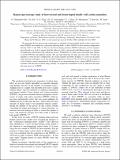Raman spectroscopy study of heat-treated and boron-doped double wall carbon nanotubes
Author(s)
Villalpando Paez, Federico; Son, H.; Chou, S. G.; Samsonidze, Ge. G.; Kim, Y. A.; Hayashi, T.; Endo, M.; Terrones, M.; Dresselhaus, Mildred; ... Show more Show less
DownloadVillalpando-Paez-2009-Raman spectroscopy s.pdf (1.167Mb)
PUBLISHER_POLICY
Publisher Policy
Article is made available in accordance with the publisher's policy and may be subject to US copyright law. Please refer to the publisher's site for terms of use.
Terms of use
Metadata
Show full item recordAbstract
We performed Raman spectroscopy experiments on undoped and boron-doped double walled carbon nanotubes (DWNTs) that exhibit the “coalescence inducing mode” as these DWNTs are heat treated to temperatures between 1200 °C and 2000 °C. The fact that boron doping promotes DWNT coalescence at lower temperatures allowed us to study in greater detail the behavior of first- and second-order Raman modes as a function of temperature with regard to the coalescence process. Furthermore, by using various excitation laser energies we probed DWNTs with different metallic (M) and semiconducting (S) inner and outer tubes. We find that regardless of their M and S configurations, the smaller diameter nanotubes disappear at a faster rate than their larger diameter counterparts as the heat treatment temperature is increased. We also observe that the frequency of the G band is mostly determined by the diameter of the semiconducting layer of those DWNTs that are in resonance with the laser excitation energy. Finally, we explain the contributions to the G′ band from the inner and outer layers of a DWNT.
Date issued
2009-07Department
Massachusetts Institute of Technology. Department of Electrical Engineering and Computer Science; Massachusetts Institute of Technology. Department of Materials Science and Engineering; Massachusetts Institute of Technology. Department of PhysicsJournal
Physical Review B
Publisher
American Physical Society
Citation
Villalpando-Paez, F. et al. “Raman spectroscopy study of heat-treated and boron-doped double wall carbon nanotubes.” Physical Review B 80.3 (2009): 035419. (C) 2010 The American Physical Society.
Version: Final published version
ISSN
1550-235X
1098-0121